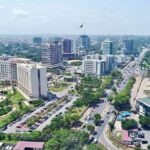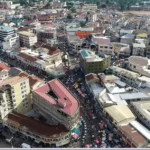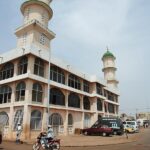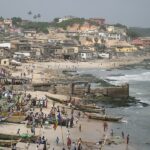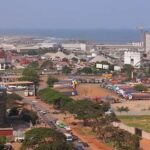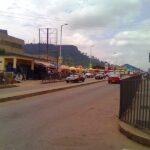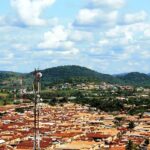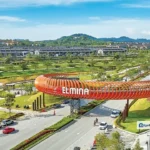Sekondi-Takoradi
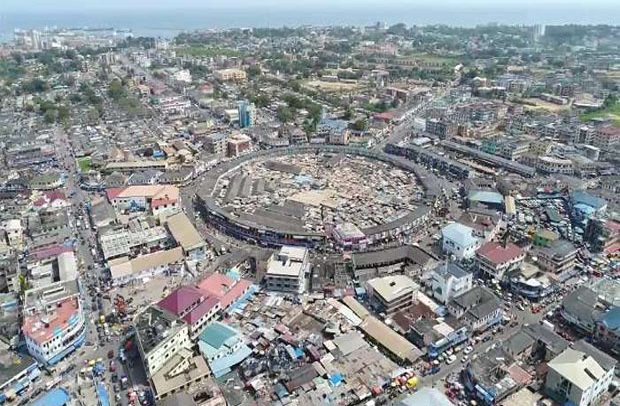
Sekondi-Takoradi, a coastal city situated on the Gulf of Guinea in southern Ghana, is positioned along an embayment of the Atlantic Ocean.
During the 17th century, both the Dutch and the British constructed forts in Sekondi, only to see them destroyed by the Ahanta. Fort Orange, originally built by the Dutch, was later reconstructed and acquired by the British in 1872; it now stands as a functioning lighthouse. The city experienced growth in the 1900s after the establishment of a railway connection to the interior goldfields. However, the significance of its surf port diminished with the inauguration of the artificial harbour in Takoradi in 1928. Sekondi and Takoradi, initially a single municipality since 1946, officially merged into one city in 1963.
Sekondi showcases a blend of old and contemporary structures across its hilly terrain, stretching down to the seashore. The old port serves fishing and pleasure vessels, with a nearby naval station. Takoradi, on the other hand, boasts a well-planned layout featuring modern buildings and tree-shaded residential zones. The harbour in Takoradi is enclosed by two breakwaters, spanning 220 acres (90 hectares), equipped with quay berths and facilities for loading bauxite and unloading oil. The harbour acts as the endpoint for several Ghana railways and is accessible by road and air. Sekondi-Takoradi is home to light industrial, agricultural, and fishing activities. The bustling market and street vending scene is predominantly managed by women. The population was recorded as 289,593 in 2000 and increased to 539,548 in 2010.
Map view
More about Sekondi-Takoradi
| ID |
|---|
| 52201 |
| Name |
| Sekondi-Takoradi |
| State ID |
| 49 |
| State Code |
| WP |
| State Name |
| Western |
| Country ID |
| 83 |
| Country Code |
| GH |
| Country Name |
| Ghana |
| Latitude |
| 4.92678000 |
| Longitude |
| -1.75773000 |
| WikiData ID |
| Q243293 |
Sekondi-Takoradi ( seh-kon-DEE tar-ku-wh-DEE) is a city in Ghana comprising the twin cities of Sekondi and Takoradi.: 4 It is the capital of Sekondi-Takoradi Metropolitan District and the Western Region of Ghana.: 2 Sekondi-Takoradi is the region's largest city as well as an industrial and commercial center with a population of 245,382 people, according to the 2021 census. Since 2021 the mayor of the city and the metropolitan area has been Abdul-Mumin Issah. Kwabena Okyere Darko-Mensah is the current member of parliament for Takoradi and Armah Blay Nyameke for Sekondi.
Both cities grew from Dutch and English forts built around the 17th century.: 2 After a railway and a deepwater seaport was built in Sekondi and Takoradi in 1903 and 1928, both cities became important economic sectors in Ghana. They merged in 1946.: 6, 8, 4
Leading industries in the city are timber, cocoa processing, plywood, shipbuilding, its harbour and railway repair, and recently, sweet crude oil and crude oil. The most common occupation in Sekondi-Takoradi is fishing. Sekondi-Takoradi lies on the main railway lines to Kumasi.
History
Etymology
Sekondi is a name derived from the Old Prussian word "Taccarary", which meant "second" after the settlement was chosen as the second location for a shallow water harbour. The origins of Takoradi is conflicted but in one account it is a combination of the Portuguese word "taccarada" or "Taccarary" (Old Prussian) and an Ahanta word "ntakor".: 2
Early settlement
Sekondi, the older and larger of the two towns, was the site of Fort Orange, Fort Witsen, and Fort Sekondi, all built in the 17th century by the Dutch. During this time, there was a huge British and Dutch influence in the town to the point where there was two political divisions: “Dutch Sekondi” and “British Sekondi”. Both collapsed after the Dutch left in 1872.: 3 The town prospered from a railroad built in 1903 to transport mineral and timber resources from the hinterland. In 1928, Ghana's first deepwater seaport was built in Takoradi.: 4
World War II
During World War II, RAF Takoradi was an important staging point for British aircraft destined for Egypt. Spitfire fighter planes were shipped in crates from England to Takoradi where they were assembled and then flown via Nigeria and Sudan to Libya. 26 Squadron SAAF was also based in Takoradi during the conflict, flying anti-submarine and convoy protection patrols over the Atlantic. Some South African airmen are buried in the Takoradi European Public cemetery.
20th century to present
Both cities amalgamated on 2 December 1946.: para. 1.2 On 20 November 1969, the city became the seat of the Roman Catholic Diocese of Sekondi–Takoradi.
Economy
The city is an important commercial center in Ghana with an industrialized economy. Its location on the coast makes it an essential hub for fishing and trading activities. The Albert Bosomtwi-Sam Fishing Harbour, located in Sekondi. It is one of the largest fishing ports in the region. Historically it was a center for the timber and cocoa industries as these resources were transported into the city for export. The Takoradi Harbour and the Takoradi Market Circle are also an important sector in the city's economy. The discovery of oil in the region in 2010 have resulted in Sekondi-Takoradi to be known as the "Oil City".
Administration
The city has a mayor–council form of government. The mayor (executive chief) is appointed by the president of Ghana and approved by the town council, the Sekondi Takoradi Metropolitan Assembly. The current mayor as of 2021 is Hon. Abdul-Mumin Issah.
Demographics
The population of Sekondi-Takoradi is 245,382 people, a -37.5% difference from the last census. Close to all of Sekondi-Takoradi's population is Christian from which 34.7% are Pentecostal/Charismatic, 25.6% are Protestant, and 14.3% are Catholic with the remaining 11.8% comprising numerous minor denominations. About 9% of the population are Muslim, 3.5% identified as non-religious and 0.2% practice traditional African religions while the remaining 0.6% practice other religions.: 34 The major people’s found in the city are the Fante followed by the Ahanta, Nzema, Asante and Wassa people.: 4
Geography
Metropolitan area
Sekondi-Takoradi is located in the Sekondi Takoradi Metropolitan, which covers a land area of 191.7 km2 (74.0 sq mi). The metropolitan bordered the Ahanta West District to the west, the Shama District towards the east, the Wassa East District to the north and the Gulf of Guinea towards the south.: 2
Climate
Sekondi-Takoradi has a tropical savanna climate (Köppen climate classification: Aw), where it experiences a wet and dry season and the temperature being hot year-round. The average annual high is 28 °C (82 °F) while the average annual low is 22.2 °C (72.0 °F). The hottest time of year is from January to May, around the time the wet season begins.
The city receives a total amount of 126 mm (5.0 in) of rainfall throughout the year, with a distinct wet and dry season. The dry season is short, spanning from December to March while the wet season is between May and June. June, the wettest month, receives on average 346 mm (13.6 in). The relative humidity in the city is small and also erratic at times due to influence of sea and land breezes. The highest humidity is experienced in August after the rainy season and is the lowest in December.
Flooding
Based on a 2017 study, Sekondi-Takoradi and the metro as a whole is prone to flooding due to its proximity to the Anankwari, Kansawura and Whin rivers. In 2009 and 2011, more than one thousand people went homeless after heavy rainfall caused the rivers to overflow their banks to the neighbouring communities.
Transportation
Sekondi is well-connected to other parts of Ghana and neighboring countries through a network of roads and railways. The city's port is a vital transportation hub, with several shipping lines providing regular services to other West African countries and Europe. The Takoradi Airport (TDI), located about 5 km from Sekondi, provides air transportation to other parts of Ghana and international destinations. There are public transport connections from Takoradi to major cities such as Accra; Kumasi; Mim; Cape Coast; Sunyani; Tamale; Tema; Ho; Wa; Bolgatanga; Elubo; Aflao; and Techiman.: 3, 4
Culture
Sekondi-Takoradi has a rich cultural heritage, and the city is home to several landmarks and tourist attractions. Fort Sekondi and the local railway museum are some notable structures originated from the colonial era. The city also have notable nightlife, with several pubs, restaurants and clubs popping out all across the city. Many annual festivals are celebrated in the city, including the Ankos Festival and the Kundum Festival.
Banks
- United Bank For Africa Gh. Ltd.
- Cal Bank
- Ghana Commercial Bank Ltd.(GCB)
- Agriculture Development Bank (ADB)
- Standard Chartered Bank Gh. Ltd. (Stanchart)
- Unibank Gh. Ltd.
- Bank of Africa Gh. Ltd.
- Social Security & National Insurance Trust (SSNIT)
- Zenith Bank Gh. Ltd.
- Prudential Bank Ltd.
- Republic Bank
Healthcare
On 5 June 2024, Mr Kwabena Okyere Darko-Mensah, the Western Regional Minister, commissioned a 60-bed capacity polyclinic in New Takoradi, an upgrade from the original facility which was a CHPS compound.
Education
The city has several secondary schools, colleges, and special schools. This is a list of senior high schools, colleges, and universities in the city:
- Senior High Schools
- St. John's School
- Ghana Senior High Technical School
- Baidoo Bonsoe Senior High Technical School
- St. Mary's Boys' Senior High School
- Methodist senior high school
- Ahantaman Senior High School
- Fijai Secondary School
- Adiembra Secondary School
- Bompeh Senior High Technical School
- Archbishop Porter Girls Secondary School
- Colleges/Universities
- Takoradi Technical University
- Nurses and Midwifery Training College
- Holy Child Teachers Training College
- Sekondi College
Takoradi Technical Institute houses a fab lab, equipped by the Massachusetts Institute of Technology (MIT), which is the first of its kind in Africa. The Western Regional Library was established in Sekondi in 1955.
Sports
Sekondi-Takoradi is home to two stadiums, Essipong Stadium and Gyandu Park. Notable sports teams based in the city are FC Takoradi, Sekondi Hasaacas, and Sekondi Wise Fighters.
Media
There are about 114 internet service providers operating in the city along with over 150 FM radio stations and 20 TV stations in the city. All of these services help with inter-communication around the residents.: 8
Sister cities
The following shows the cities Sekondi-Takoradi is twined with:
Notable people
- Gyedu-Blay Ambolley, musician
- Ben Bentil (born 1995), basketball player for Hapoel Tel Aviv of the Israeli Basketball Premier League
- Esther Cobbah, communication specialist
- Joseph Henry Smith, ambassador of Ghana to the United States
- Mokowa Blay Adu-Gyamfi, former Ghanaian diplomat, current presidential advisor on HIV/AIDS at the Office of the President of Ghana
- Shasha Marley, musician
- Kiki Gyan, musician
See also
- Takoradi Harbour
- List of railway stations in Ghana
- Bombei Festival
Explanatory notes
References
Further reading
- Sofo, E.; Avoke, E.; Bodjawah, E. (2023). "Morphing Identity and Style in Contemporary Ghanaian Painting: Two Artists From Sekondi-Takoradi". African Arts. 56 (4). MIT Press: 42–61. doi:10.1162/afar_a_00729. ISSN 0001-9933.
External links
- Official website
- "Sekondi-Takoradi". Encyclopædia Britannica. 2022 [1998]. Archived from the original on 2 December 2023.
- Chisholm, Hugh, ed. (1911). "Sekondi". Encyclopædia Britannica (11th ed.). Cambridge University Press.
References
- http://www.bibliovault.org/BV.book.epl?BookId=3985
- http://www.ghanaports.gov.gh/GPHA/takoradi/index.html
- http://www.infoplease.com/ce6/world/A0844338.html
- http://www.southafricawargraves.org/lists/ghana.htm
- http://www.ghanaschoolsonline.com/intermediate/shs.cfm?levelID=2
- https://web.archive.org/web/20120325210700/http://www.ghanaschoolsonline.com/intermediate/shs.cfm?levelID=2
- https://web.archive.org/web/20071231042243/http://www.ghanaports.gov.gh/GPHA/takoradi/index.html
- http://ireport.cnn.com/docs/DOC-1071449
- http://www.dwd.de/DWD/klima/beratung/ak/ak_654670_kt.pdf
- https://www.wikidata.org/wiki/Q243293#identifiers
